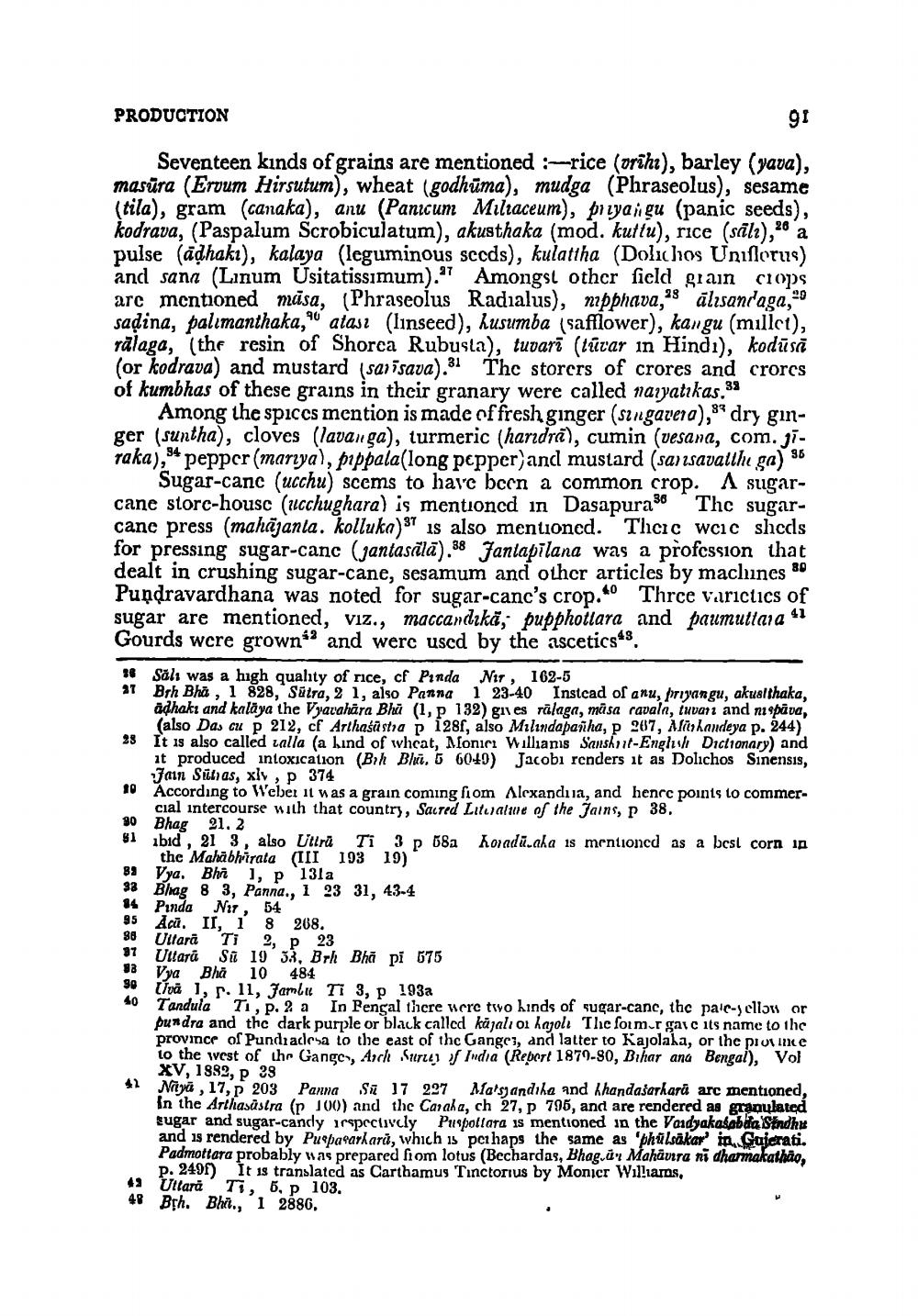________________
91
Seventeen kinds of grains are mentioned :-rice (orihi), barley (yava), masura (Ervum Hirsutum), wheat (godhuma), mudga (Phraseolus), sesame (tila), gram (canaka), anu (Panicum Miliaceum), yangu (panic seeds), kodrava, (Paspalum Scrobiculatum), akusthaka (mod. kuttu), rice (sāli),20 a pulse (adhaki), kalaya (leguminous seeds), kulattha (Dolichos Uniflorus) and sana (Linum Usitatissimum). Amongst other field grain crops are mentioned māsa, (Phraseolus Radialus), mpphava," alisandaga, sadina, palimanthaka, atası (linseed), husumba (safflower), kangu (millet), ૧ ralaga, (the resin of Shorca Rubusta), tuvari (tuvar in Hindi), kodūsā (or kodrava) and mustard (sarisava).31 The storers of crores and crores of kumbhas of these grains in their granary were called naiyatikas.
83
35
Among the spices mention is made of fresh ginger (singavera), dry ginger (suntha), cloves (lavanga), turmeric (haridra), cumin (vesana, com. jiraka), pepper (mariya), pippala(long pepper) and mustard (sansavatthi ga) Sugar-canc (ucchu) seems to have been a common crop. A sugarcane store-house (ucchughara) is mentioned in Dasapura The sugarcane press (mahajanta. kolluka) is also mentioned. There were sheds for pressing sugar-canc (jantasalā).38 Janlapilana was a profession that dealt in crushing sugar-cane, sesamum and other articles by maclunes 0 Pundravardhana was noted for sugar-canc's crop. 40 Three varictics of sugar are mentioned, viz., maccandika, pupphotlara and paumuttara 11 Gourds were grown and were used by the ascetics48.
PRODUCTION
86 Sali was a high quality of rice, cf Pinda Nir, 162-5
27 Brh Bha, 1 828, Sutra, 2 1, also Panna 1 23-40 Instead of anu, priyangu, akusithaka, adhaki and kalaya the Vyavahara Bhi (1, p 132) gives ralaga, māsa cavala, tuvan and mspava, (also Das cu p 212, cf Arthasüstra p 128f, also Milindapanha, p 267, Markandeya p. 244) It is also called valla (a kind of wheat, Monier Williams Sanskrit-English Dictionary) and it produced intoxication (Bih Bha. 5 6049) Jacobi renders it as Dolichos Sinensis, Jain Sutras, xlv, p 374
23
10 According to Weber it was a grain coming from Alexandria, and hence points to commercial intercourse with that country, Sacred Literatue of the Jains, p 38. 30 Bhag 21. 2
51 ibid, 21 3, also Uttra
horadu.aka is mentioned as a best corn in
Ti 3 p 58a
the Mahabhirata (III 193 19)
83
Vya. Bhi 1, p 131a
33 Bhag 8 3, Panna., 1 23 31, 43-4
34 Pinda Nir, 54
95 Acu. II, 1 8 268.
38 Uttara Ti 2, p 23
87 Uttara Su 19 33, Brh Bha pi 575
88 Vya Bha 10 484
90 Livä 1, r. 11, Jambu Ti 3, p 193a
40 Tandula Ti, p. 2 a In Pengal there were two kinds of sugar-cane, the pale-yellow or pundra and the dark purple or black called kajali o hayoli The former gave its name to the province of Pundradesa to the east of the Ganges, and latter to Kajolaka, or the province to the west of the Ganges, Arch Survey of India (Report 1879-80, Bihar and Bengal), Vol XV, 1882, p 29
41 Naya, 17, p 203 Panna Sz 17 227 Marsjandika and khandasarhara arc mentioned, in the Arthasästra (p 100) and the Caraka, ch 27, p 795, and are rendered as granulated sugar and sugar-candy irspectively Puspoltara is mentioned in the Vaidyakasabda Sindhu and is rendered by Puspasarkard, which is perhaps the same as 'phülsäkar in Gujerati. Padmottara probably was prepared from lotus (Bechardas, Bhag.an Mahavira ni dharmakathão, p. 249f) It is translated as Carthamus Tinctorius by Monier Williams, 43 Uttara Ti, 5, p 103.
48 Bth. Bha., 1 2886.




